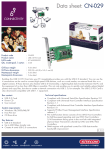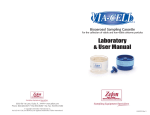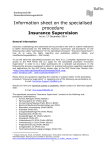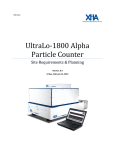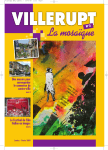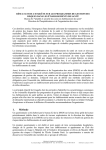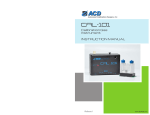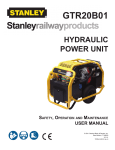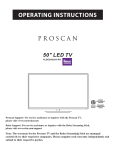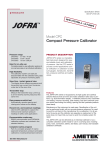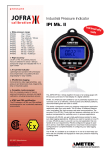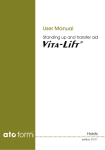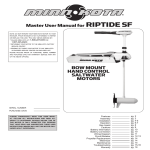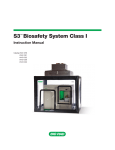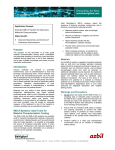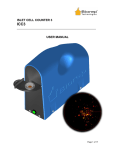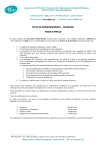Download Indoor Mold Sampling
Transcript
PDHonline Course C215 (2 PDH) Indoor Mold Sampling Instructor: John Poullain, PE 2012 PDH Online | PDH Center 5272 Meadow Estates Drive Fairfax, VA 22030-6658 Phone & Fax: 703-988-0088 www.PDHonline.org www.PDHcenter.com An Approved Continuing Education Provider Revision1 Page 1 of 8 EAM Environmental & Analytical Management, Inc Procedures for IAQ sampling. 1. Non-culturable Sampling :• Air-O-Cell™ Air Sampling Cassettes and/or Micro5 MicroCells. • Surface Sampling – Tapelift, bulk or swab samples. 2. Culturable sampling :(MEA) Malt Extract Agar (PDA) Potato Dextrose Agar Written by: _______________________________ Date:___________________ Revised by:_______________________________ Date:___________________ Approved by:______________________________ Date:___________________ C:\SharedDocs\QA QC\Microbiology\SOP'S\Microbiology SOP's\Procedures for IAQ Sampling Rev 04272005.doc Revision1 Page 2 of 8 Procedures for IAQ sampling. 1. Non-culturable sampling. • Spore Traps Air-O-Cell™ Air Sampling Cassettes or Micro5 MicroCells. Summary The purpose of sampling is to investigate whether biological microorganisms in a particular environment are presenting a health hazard to certain individuals. The goal of sampling is to determine the sources of indoor contaminants to allow for effective remediation. Sampling protocols should include indoor problem areas, a non-problem area where possible and a(n) outdoor reference sample(s). Spore Trap samplers are designed for the rapid collection and analysis of a wide range of airborne aerosols including organic (mold spores, pollen, insect parts) and inorganic particles (fly ash, dust) and fibers (asbestos, fiberglass etc.). As the air enters the spore trap cassette, any particulate matter it contains becomes impacted onto the adherent sampling substrate creating a deposit or "trace", while the air flow continues through the exit orifice. Sample Collection, Preservation, Shipment and Storage: 1. After sampling, samples should be sent to the laboratory in a sealed container as soon as possible, by mail, courier or in person. 2. All samples should be stored at room temperature. Sampling Duration Air-O-Cells™ Air Sampling Cassettes Air-O-Cells Air Sampling Cassettes are designed to operate at a flow rate of 15 Liters per minute (15 L/min). A lower flow rate can result in the loss of some spores and accumulation of others in a non-uniform manner, while a higher rate can cause mechanical damage to spores. Micro5 MicroCells. Micro5 MicroCells are designed to operate at a flow rate of 5 L/min for optimum collection efficiency, which results in a uniform collection trace. Sampling times vary depending on the density of particulate in the environment (see chart below). Product Air-O-Cell™ Air Sampling Cassette @15LPM Micro5 MicroCell @5LPM Clean “office” or outdoors (no visible dust) 10 minutes Indoor environment high activity & personnel 5 minutes Indoor environment. Drywall renovation or heavy industrial dust. 1 minute 8 - 10 minutes 5 minutes 1- 3 minutes C:\SharedDocs\QA QC\Microbiology\SOP'S\Microbiology SOP's\Procedures for IAQ Sampling Rev 04272005.doc Revision1 Page 3 of 8 Equipment and supplies 1. Spore Trap Cassettes 2. Flexible Tubing 3. Air sampling Vacuum Pump capable of operating at 15 liters per minute (LPM) when using Air-O-Cell™ Air Sampling Cassettes or at 5 L/min when using Micro5 MicroCells. 4. EAM Laboratories Chain of Custody Procedure for Air-O-Cell™ Air Sampling Cassette 1. Calibrate the pump to 15L/min. 2. Remove and retain tape seal covering the inlet and outlet. 3. Attach the outlet (round hole) to the supplied tubing adapter or use standard ½"(½ inch) PVC tubing (for high volume pumps only). Attach other end of tubing to Vacuum Pump. Air flow direction should be from the environment to pump. 4. Hold cassette so it is approximately 4 feet above the ground. Switch pump on and sample for appropriate time. (see chart) 5. Remove Air-O-Cell™ cassette from tubing and reseal with the original tape. Label sample. 6. Complete an EAM Laboratories Chain of Custody. Include the project name, total volumes, sampling rate, date & time sampled. Ensure person relinquishing samples has signed Chain of Custody with date & time relinquished. 7. Shipping in a corrugated box or hand delivery to the laboratory is recommended to reduce the risk of damage to the AirOCell Air Sampling Cassette Procedure for Micro5 MicroCells 1. Calibrate the pump to 5L/min. 2. Remove the black pin from the bottom of the Micro5 MicroCell. Connect one end of tubing (5 feet or less) to the bottom of the Micro5 MicroCell, attach other end of tubing to Vacuum Pump. Air flow direction should be from the environment to the pump. 3. Remove black cap from the top of the Micro5 MicroCell. Hold cassette so it is approximately 4 feet above the ground. Switch pump on and sample for appropriate time. (see chart) 4. When complete, replace black pin to bottom and cap to top of the Micro5 MicroCell. Label sample. 5. Complete an EAM Laboratories Chain of Custody. Include the project name, total volumes, sampling rate, date & time sampled. Ensure person relinquishing samples has signed Chain of Custody with date & time relinquished. 6. Promptly send samples to laboratory. Quality Control: 1. Do not use spore traps that appear damaged or are expired. 2. Check and recalibrate the Vacuum Pump prior to all sampling. 3. An outdoor ambient sample should always be obtained for reference purposes. 4. Collect a sample from a noncompliant indoor area for comparison. 5. Periodically send in a blank cassette for analysis. C:\SharedDocs\QA QC\Microbiology\SOP'S\Microbiology SOP's\Procedures for IAQ Sampling Rev 04272005.doc Revision1 Page 4 of 8 Surface Sampling – Tape-lift, bulk or swab samples. • Tape-lift samples Summary Surface sampling is a non-destructive technique that allows for the determination of possible microbial contamination of suspect sites eg visibly stained or discolored areas. It is especially useful for the sampling of valuable and/or non-transportable materials. Direct microscopic examination of a surface will indicate exactly which genera are present including those which may not grow on normal microbiological media. Tape-lift samples and surface-wash (swab) samples are the most convenient methods of surface sampling currently in general use. Adhesive tape samples provide semi-quantitative results for total fungal contamination, ie whether or not mold is growing on the surface sampled, and the different genera present. Most surfaces will collect a mix of spores normally present in the environment; at times it is possible to note a skewing of the normal distribution of spore types, and also to note "marker" genera which may indicate indoor mold growth. Marker genera are those which are normally present in small numbers but will multiply indoors under favorable conditions eg Chaetomium and Stachybotrys both of which digest cellulose. Sample Collection, Preservation, Shipment and Storage: • Tape-lift samples should be sent to the laboratory by mail, courier or in person, in a plastic slide container, as soon as possible after sampling, preferably within 24 hrs. • Maintain sample at room temperature. Equipment and Supplies • Gloves. • Scissors. • Microscope Slides. Sampling Procedure 1. Wear gloves. 2. Label clean microscope slide with correct sample number. 3. Examine suspect area with naked eye to identify areas of possible fungal growth. 4. Use clear adhesive tape eg Scotch™ Transparent Tape 3M . Cut a piece of tape 1-2 inches long. HANDLE ENDS ONLY. Place tape strip over suspect area and press gently but firmly. 5. Slowly peel back/remove tape from surface. 6. Transfer tape to labeled microscope slide. 7. Store in slide box and maintain at room temperature. C:\SharedDocs\QA QC\Microbiology\SOP'S\Microbiology SOP's\Procedures for IAQ Sampling Rev 04272005.doc Revision1 Page 5 of 8 • Bulk Samples Summary Any type of environmental material - settled dust, sections of wallboard, pieces of duct lining, carpet segments, wood, wall paper, clothing etc., - can be considered a bulk sample. A representative sample of substrate with the suspect mold intact is removed, properly sealed in a plastic bag to prevent dispersal of any potential pathogenic spores and/or cross contamination, and transported to the laboratory for analysis. This method provides good data on whether fungal/mold growth is occurring on a surface. Direct sampling can reveal indoor reservoirs of spores that have not yet become airborne. Sample Collection. Preservation, Shipment and Storage • A representative sample is cut or removed aseptically from the source. • As soon as possible after sampling, samples should be sent to the laboratory by mail, courier or in person in a sealed container as soon. • Maintain samples at room temperature. Preparation of a Tape Lift sample • Label clean microscope slide with correct sample ID. • Identify area of interest on bulk sample. • Cut a piece of Scotch® Transparent Tape 1-2″ (1-2 inches) long. • Press tape onto sample surface and carefully peel back. • Place drop of Lactophenol cotton blue on slide (optional) • Transfer tape to microscope slide. - Carpet check using PCM Air Sampling Cassettes. Summary Zefon PCM air sampling cassettes are designed and manufactured to meet all applicable NIOSH OSHA and EPA standards. The method used is a variation of the NIOSH Method 7400 (Asbestos and Other fibres by PCM) adapted for use with other particulates by means of alternate counting rules. Detection limits vary from laboratory to laboratory and are dependent on sample size, cassette matrix and quantity of interfering dust present in the sample. Sample Overload may be observed in the field, if >50% of filter surface is covered with particles this sample will be too difficult to count. Another sample should be obtained using a shorter time period. In the laboratory, if >20% of field of view is obscured by clumping or an agglomerate it should not be counted. Equipment & Supplies 1. PCM air sampling cassettes 2. Flexible Tubing 3. Air sampling Vacuum Pump capable of operating at 3-15 liters per minute (LPM) 4. Tape to seal connection of PCM to tubing while sampling. C:\SharedDocs\QA QC\Microbiology\SOP'S\Microbiology SOP's\Procedures for IAQ Sampling Rev 04272005.doc Revision1 Page 6 of 8 Sampling Procedure 1. Examine carpet for visibly stained (eg water stains) and/or discolored areas. 2. Attach PCM unit to hose using tape to seal connection. 3. Set pump volume to 10 LPM and adjust sampling time depending on how contaminated or dirty the area to be sampled. 4. Sample area under investigation after for 5 min, check cassette filter for amount of debris building up on filter. If > 50% covered resample for < 5 min. If <50%, sample for another 3-5 min. 5. Carefully remove PCM from tubing, reseal cassette. Label with correct sample number. 6. Transport to laboratory for analysis. • Swab samples Summary Surface sampling is a non-destructive technique that allows for the determination of possible microbial contamination of suspect sites eg visibly stained or discolored areas. It is especially useful for the sampling of valuable and/or non-transportable materials. Tape-lift samples and surface-wash (swab) samples are the most convenient methods of surface sampling currently in general use. The swab has the advantage of enabling a sample to be taken in a hard to reach area without a need to remove any material, and is a neutral, stable way to transport the sample. Swab sampling is performed using a sterile tip wetted with a buffering solution that can be applied to agar plates (viable spores) or microscope slides for direct examination for the presence of spores. Sample Collection, Preservation, Shipment and Storage: • Swab samples should be sent to the laboratory by mail, courier or in person, in a sealed container, as soon as possible after sampling. Preferably within 24 hrs. • Maintain swab at room temperature. Equipment & Supplies • Swabs • Malt Extract Agar Plates (MEA) for General Mold Identification • Potato Dextrose Agar Plates (PDA) for Culturing of Stachybotrys spp. • Gloves. Sampling Procedure 1. Wear gloves 2. Identify suspect areas eg behind appliances in kitchen, under sinks etc. 3. Carefully remove swab from packaging ensuring tip is wetted with buffer. 4. Swab area thoroughly using a rolling motion, try to completely swab chosen area. 5. Replace swab into tube and seal tightly.Label with correct sample number. 6. Maintain samples at room temperature and immediately transport to laboratory for incubation and analysis. C:\SharedDocs\QA QC\Microbiology\SOP'S\Microbiology SOP's\Procedures for IAQ Sampling Rev 04272005.doc Revision1 Page 7 of 8 2. Culturable sampling. • Microbiological Media plates. Summary Culturable sampling is one of the most commonly used methods of volumetric air sampling. The objective of this method is to assess the quantity of viable (alive and capable of germination) spores contained in a known volume of air drawn over the surface of a microbiological media plate. Spores that impact onto the plate are then allowed to incubate and grow (7 days @ 25˚C). After incubation, colonies of each genera can then be counted and identified. Culturable sampling allows for the differentiation of Aspergillus and Penicillium, standard speciation of Aspergillus, and identification of other fungi. Variation is an inherent part of biological air sampling, and culturable sampling methods require that spores survive the sampling process, germinate on the sampling medium used, and compete well with other species present. Some fungi do not grow well or at all in culture. Some organisms cannot be identified, as they fail to produce spores, or have not yet been scientifically characterized. Culturable sampling does not indicate the presence of non-viable spores, which may also be capable of producing allergens and/or irritation. There are a number of different media types available depending on the sampling objective, unless fungi of a specific type are suspected, the sampling medium should support growth of the widest variety of common fungi eg Malt Extract Agar (MEA). This method may also be used for bacterial counts. Sampling locations should include problem areas, indoor and outdoor samples for comparison. Equipment and Supplies • Gloves. • Andersen sampler OR other culturable air sampler • Vacuum pump calibrated to sample 28.3 LPM Media Required • Malt Extract Agar (MEA) General Mold Identification. • Potato Dextrose Agar (PDA) Growth of Stachybotrys spp. Sampling Procedure 1. Select problem areas for sampling. 2. Calibrate pump to sample 28.3 LPM (Andersen sampler) 3. A 3 minute sampling is a good general guideline however sampling times should be adjusted if there is visible mold growth or heavy dust particulates. (See Table below.) Environmetal Conditions Dusty, dirty, visible particulates in air Normal office/household/outdoor reference Clean area Sampling Time @ 28.3 LPM 1 min 2-3 min 4-5 min 4. After sampling, wrap plate(s) with PARAFILM® "M" to avoid dehydration of the medium, this also reduces the likelihood of contamination. Label plates with correct sample number(s). 5. Transport plates to laboratory for incubation and analysis. C:\SharedDocs\QA QC\Microbiology\SOP'S\Microbiology SOP's\Procedures for IAQ Sampling Rev 04272005.doc Revision1 Page 8 of 8 General Guidelines for good practice when sampling Walk through/survey area to be sampled – identify any visibly contaminated areas as well as clean areas for comparison. Decide on number of samples to be taken while surveying area. Assemble all necessary supplies before beginning sampling. Calibrate air sampling pump before use. Label all samples as job progresses, this will avoid any possibility of samples being mislabeled. Tape-lift or swab samples should be taken where surfaces are visibly contaminated. Enter date of sampling on Chain of Custody. Ensure sample number and description match Chain of Custody. Include all sampling times and volumes eg 10 min@ 15 Liters per min (Culturable/non-culturable samples) Relevant data such as prevailing atmospheric conditions ie windy, rainy, dry, sunny, humidity and temperature should also be recorded. It is recommended that two consecutive outdoor samples be done for comparison purposes. Once all relevant information is included on Chain of Custody, return it to laboratory along with samples as soon as possible after sampling. References: 1. Sampling and Calibration for Atmospheric Measurements. John K. Taylor, Editor. National Bureau of Standards, Boulder, CO 1985 2. Air-O-Cell Air Sampling Cassette - Brochure. Zefon International, 3860 23rd Ave North, St. Petersburg, FL 33713. www.zefon.com 3. User Manual for AirOCell Air Quality Particle Sampler. Zefon International, 3860 23rd Ave North, St. Petersburg, FL 33713. www.zefon.com 4. The NEXT GENERATION OF SPORE TRAPS. Micro5 MicroCell - Brochure. www.emssales.net 5. EMSL Analytical, Inc. www.emsl.com 6. www.emlab.com/s/sampling/Culture.html 7. www.emlab.com/s/sampling/Surface.html 8. www.emlab.com/s/sampling/Nonculture.html 9. NIOSH Manual of Analytical Methods 4th Edition. Casinelli, M.E and O’Connor, P,F., (Eds.) DHHS (NIOSH) Publication 94-113 (August,1998) C:\SharedDocs\QA QC\Microbiology\SOP'S\Microbiology SOP's\Procedures for IAQ Sampling Rev 04272005.doc









